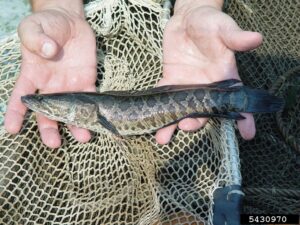
Alewife
This invasive species competes for plankton and aquatic organisms amongst native lake herring, whitefish, chubs, and perch, which negatively affects these species.

This invasive species competes for plankton and aquatic organisms amongst native lake herring, whitefish, chubs, and perch, which negatively affects these species.

Invasive carp are a tremendous threat to the Great Lakes and could devastate the lakes if they enter our Great Lakes ecosystem. The invasive carp includes four species: black carp, grass carp, bighead carp, and silver carp.

As with many non-native and invasive species, snakehead fish have no natural predators in the United States. This allows for competition and consumption of native fish species. Additionally, Northern snakehead fish can survive in waters with low oxygen levels, giving them a competitive advantage over native species.

Round gobies originated in the Black and Caspian Seas. They were introduced into the Great Lakes by ballast water discharges from ships and were first discovered in 1990 along the St. Clair River (a Canadian river north of Detroit). Round gobies are a threat because of they are capable of rapid population growth after they reach new areas.

Sea Lamprey are primitive, jawless fish native to the Atlantic Ocean. In 1921, lampreys appeared in Lake Erie for the first time, arriving via the Welland Canal, which was constructed for ships to avoid Niagara Falls on their way up the St. Lawrence Seaway. Shortly thereafter, sea lamprey quickly populated all of the upper Great Lakes.
Every dollar invested in Tip of the Mitt Watershed Council helps leverage government and foundation grants for much needed local water quality monitoring and pollution prevention, invasive species management, shoreline restoration, education, and much more.

The Tip of the Mitt Watershed Council is a nonprofit, tax-exempt charitable organization under Section 501(c)(3) of the U.S. Internal Revenue Code. Donations are tax-deductible as allowed by law.
Our employee identification number (EIN) is 38-2361745.
Every effort has been made to ensure the accuracy of information herein; however, it cannot be guaranteed.
Unless otherwise noted, all contents of this website are property of Tip of the Mitt Watershed Council © 2023. All rights reserved.